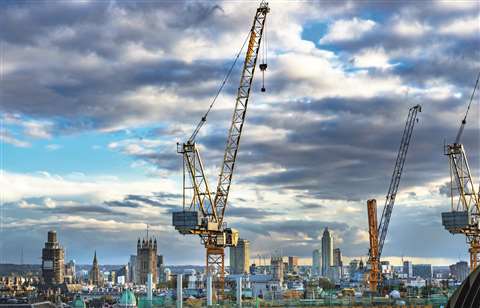Outlook for UK construction
11 March 2022
UK construction is emerging from the Covid pandemic relatively strongly, but is not, as Scott Hazelton of IHS Markit reports, without its challenges.
The UK economy is slowing with real GDP growth retreating from a likely 6.9% pace in 2021 to anticipated growth of 4.0% in 2022. This does imply that the country will regain the 9.7% loss of GDP in 2020 by mid-2022.
 (Photo: Adobe Stock)
(Photo: Adobe Stock)
Real GDP growth stalled in October 2021, even before the emergence of the Omicron variant. While lockdowns have not been re-implemented, tighter restrictions further impede the recovery of hospitality and leisure sectors from past lockdowns.
The immediate real GDP outlook is challenged by rising energy prices and increased tax burdens for UK households. The recovery also faces growing obstacles from disrupted supply chains and acute labour and fuel shortages, particularly in the haulage, hospitality, and food-processing sectors.
Meanwhile, the Bank of England (BoE) has begun tightening to tame inflation. The first interest rate increase occurred in December 2021, with two further rate increases expected in both 2022 and 2023.
Solid construction
On the construction front, recent evidence remains somewhat positive. At 54.3, the December IHS Markit Construction PMI data indicated growth and remained above the 50.0 no-change threshold, but the index was down from 55.5 in November and signalled the weakest rate of expansion since September.
Higher levels of new work have now been recorded for 19 consecutive months, but there is some evidence that tighter pandemic restrictions and rising Covid-19 cases negatively impacted construction activity, especially in the commercial sector.
On the plus side, the number of construction firms reporting supplier delays dropped from 47% in November to 34% in December, suggesting that supply constraints may be ameliorating – this was the least marked downturn in supplier performance since November 2020.
Higher fuel, energy and raw material prices continued to push up average cost burdens across the construction sector in December. However, the overall rate of inflation eased for the fourth month running to its lowest since March.
Looking ahead, just over half of the survey panel (51%) forecast a rise in business activity during 2022, while only 9% predict a decline.
The outlook for UK construction is for continued, but slowing, growth. Total real construction spending likely recovered 4.2% in 2021 after a precipitous 15.5% drop in 2020.
IHS Markit expects growth to moderate to 2.1% in 2022 with a bit stronger bounce to 2.8% in 2023. Between economic headwinds and uncertainty of the UK’s trade relationship with the EU, construction growth will remain challenged and UK construction spending will not re-attain 2019 levels in real terms until 2025.
However, given inflation, which is high by recent historical standard, 2019 nominal levels will be achieved in 2023.
‘Tepid’ growth
Most construction segments experienced recovery in 2021, with the exception of infrastructure where every element – transportation, energy and water/sewer – saw very modest retreats.
Residential is the largest construction segment and experienced a decent recovery in 2021, with 4.0% real growth. Inflation was strongest in this segment with nominal growth of 12.8%.
In simple terms, one can use nominal growth as an indicator of the increase in construction business revenue, while real growth would closely approximate the outlook for square metres of construction.
We do expect both nominal and real residential growth to remain tepid over the forecast as high housing costs combine with increasing interest rates and overall consumer inflation to limit housing affordability.
While residential construction growth usually leads the overall market, it will only roughly keep pace with the average over the next few years.
The broad non-residential segment will perform on a par with residential construction over the near-term. The industrial segment will be challenged, however, with uncertainty around Brexit, transportation and supply chain issues weighing on the business confidence necessary to justify future expansion.
As these issues are resolved in 2023 and beyond, construction of industrial structure will progressively improve; indeed industrial construction is projected to lead market growth by 2024. Commercial is the near-term beneficiary, but this is partially due to base effects.
As the Covid-induced downturn disproportionately impacted hospitality, any recovery from the steep drop will drive outsized growth. A further hindrance to growth will be the evolution of the retail sector.
As e-commerce continues to consume an ever-larger share of wallet, conventional store growth will subside. While warehousing and logistics will see strong growth, the value of these structures is less than that of retail with a net negative effect.
It will be 2026 before this market recovers to its 2019 size in real terms. Office will be similarly impacted.
While there will be a return to office, the proven ability of some professions to work from home will reduce the necessary office space for employee. It will take several years to rationalise the current office stock with projected employee in-office hours.
Regional variations
Infrastructure also recovers as the end of Covid-support spending allows for funds to be re-purposed, particularly into transportation projects.
Nevertheless, deep fiscal challenges await to close significant wide public sector fiscal shortfalls, with the process to repair the accounts to gather significant momentum in 2023–26.
This will exert some resistance to the public spending that drives most UK infrastructure.
Looking at the UK by region, Northern and Eastern England have led growth over the past five years, closely followed by London.
The disproportionate impact of the pandemic in 2020 can distort the historical data. More importantly, looking ahead, the strongest growth in construction spending is expected in London, which already had a very strong 2021.
East of London and the Midlands are also poised for strong growth. However, the Midlands were the hardest hit region in 2020, so some of the strength is base effect – a recovery from a low level.
Wales and Scotland have the strongest turnarounds from the past five years. For Wales, this is also something of a base effect from a tough 2020, but for Scotland, this is a true, sustained strong outlook with sustained growth in the 4% to 5% range for the medium term.
CE Barometer - Current challenges fail to dampen long-term optimism - CE December 2021 survey results
The barometer survey for the month of December 2021 was undertaken during the first three weeks of January 2022.
In general, construction was relatively slow at the end of 2021, with the triple whammy of Covid measures, supply chain issues and skills shortages negatively affecting both the speed and cost of projects.
For these reasons, the balance figure for this month (the difference between those reporting positive and negative movement, when comparing November and December, 2021) has fallen to -6.9%, its lowest point since February 2020.
Given that last month’s barometer saw a negative result of -1.5%, this consecutive fall could be seen as a sign of trouble ahead.
Figures point to confidence in growth
In fact, respondents reported that business was still improved from the same time last year – and further reported that they expect it to be better still a year from now.
Looking back, 54.2% of respondents reported improvement from a year ago, with only 12.5% claiming business is now worse.
Similarly, 56.9% of respondents predicted that business will go on to improve in 12 months’ time, while, again, just 12.5% expect things to be worse.
Overall, the business climate now stands at 26.4%, a fractional improvement on last month’s 25.9%, but well behind the 50.7% high of last May. A reality check, perhaps?

About the author
Scott Hazelton is a director with the Global Construction team at the market analyst IHS Markit.
Scott has over 30 years’ experience in construction, heavy equipment, building materials and industrial manufacturing markets.
CONECTAR-SE COM A EQUIPE






